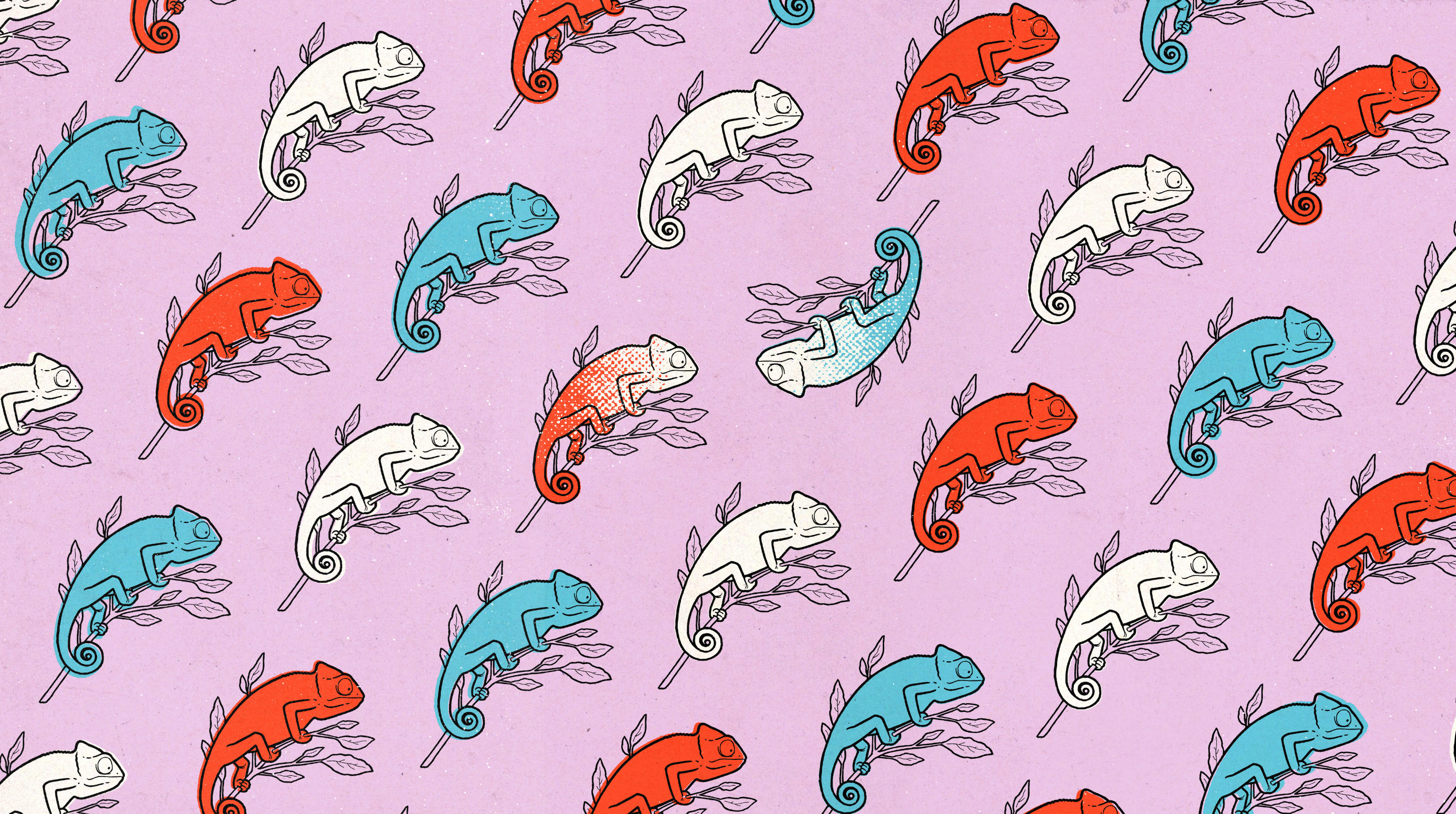Why Are There Two Sexes?

Dan Page for Quanta Magazine
Introduction
Sex is one of the greatest mysteries in biology. Why on earth do most large complex animals have two sexes? Asexual reproduction can efficiently produce twice as many offspring as sexual reproduction without the complications of finding and courting a mate. There must be major benefits to having two sexes, but if so, why shouldn’t three sexes be even better? Isaac Asimov explored this complicated scenario in his 1972 Nebula Award-winning novel “The Gods Themselves,” and he wasn’t the only science fiction writer to do so. Is there some reason why three is definitely a crowd?
Many biological hypotheses have been proposed to explain the mystery. In this column, we’ll approach the system from a different point of view: Are there any interesting mathematical principles that we can bring to bear on these questions, irrespective of the biological details? Of course there are!
Our first problem concerns an interesting mathematical conundrum that could arise in the case of three sexes. A new species of chameleon was discovered in the Southwestern United States on July 4, the first species found to have three sexes. This species has been aptly named Chamaeleo americanus patrioticus for reasons we specify below.
Problem 1
The adults of this Chamaeleo americanus patrioticus are colored fully red, white or blue, and this defines their sex at a given time. Being chameleons, however, they can and do change color, and therefore their sex. Specifically, when two differently colored individuals meet face to face, as happens quite frequently, they both change to the third color, as you can see in the illustration above. The chameleons retain this new color till the next such encounter with an individual of a different color. In effect, the color change is like blushing — a signal that says “not now.” There could be hundreds of such blushing encounters before the chameleons of two different colors are familiar enough to mate. What concerns us is that, for an animal breeder, this behavior can result in the dreaded problem of unicolorization before breeding can even start. If these color-changing encounters cause all your chameleons to change to the same color, you are out of luck — same-colored individuals cannot reproduce with each other. Whether unicolorization can happen or not in a given group of chameleons is crucially dependent on the number of individuals of each color that you start out with. Some sets of numbers almost invariably result in unicolorization of the group sooner or later, while others never do. Can you predict whether unicolorization can happen if you start with the numbers of these chameleons specified in A, B and C below, and if so, how?
A) 8 red, 5 white and 14 blue;
B) 9 red, 10 white and 16 blue
And finally, of course:
C) 7 red, 6 white and 50 blueBased on the above, can you figure out a general rule on how many individuals of each of the three colors you should start out with, so that the group is resistant to unicolorization?
As you’ve no doubt guessed, Chamaeleo americanus patrioticus is fictitious, a contrivance to present a mathematical principle — how something like parity can function when there are three different kinds of individuals. However, I do have a different, deep mathematical insight that sheds light on why animals that have two sexes are more successful than those that are asexual. To understand it, we need to make a little digression into some arithmetic. Consider the following simple problem, which has an “aha!”-inducing solution that I’d like you to discover for yourself. If you don’t get the insight right away, I’ve provided hints to help you get there. Below the hints, I will give you the correct answer, because it illuminates my mathematical argument that two sexes should exist. So only if you don’t find it for yourself, please do look at the answer.
Problem 2
Imagine all the human beings in the world (more than seven billion of them) standing in a line. Now multiply all the fingers on each of their hands. For the first person in line, you will multiply the five fingers on her left hand by the five on her right to get 25. You will then multiply this number by the five fingers on the left hand of your next person and then by five on his right hand and so on. Which of the following will approximate the final product after all the multiplications are done?
A) 5 to the 7 billion
B) 10 to the 7 billion
C) 5 to the 14 billion
D) Something else entirelyHint: This problem is not to test your arithmetic: it’s a trick question!
Hint: Some people may be missing fingers.
Hint: Some people may be missing a lot of their fingers!
Answer: The correct choice is D, and the answer to the problem is zero. As long as there is even one individual who has lost all his or her fingers on one hand, as there definitely is somewhere in the world, the product will come out to be zero.
This problem illustrates what I call “the fatal problem of serial multiplication” — the fact that a serial product can vanish because of a single multiplication by nothing. It’s a malady that mere addition doesn’t suffer from. And how does this relate to the problem of two sexes? Well, as we saw in the May insights column, Can Darwinian Evolution Explain Lamarckism?, evolutionary-fitness calculations over many generations are essentially serial multiplications. And there’s a key difference between asexual and sexual populations. As I mentioned in a comment on the May column, consider the fascinating statistic that 30 to 60 percent of the population of Europe was decimated by the bubonic plague (the Black Death) in the 14th century. What would the number have been if we were asexual creatures who were genetically very similar or identical to one another? 90 percent? 99 percent? Extinction? The different genetic makeup that each human being possesses, thanks to sexual reproduction, makes each of us react somewhat differently to parasites: some of us succumb, others may get a serious infection but survive, still others may escape with a mild infection. For asexual creatures, every individual reacts in the same way. For a parasite, this is equivalent to all the houses in the town using the same kind of lock. Find the key, and you hit the jackpot: you can literally make a killing!
We can simplistically define an animal’s fitness f as the number of adult offspring that it produces. Essentially, the population of a species in the next generation then is simply the starting population multiplied by f. The long-term population after n generations is simply a set of serial multiplications from one generation to another, with the average f varying from one generation to another based on the conditions. While it is true that asexual creatures will tend to have a higher f most of the time compared with sexual creatures, there will be some rare catastrophes when the number f falls for both species, but really plunges for asexual creatures for whom it may approach or reach zero. And when that happens, boom — extinction, in a single stroke!
Lizards are particularly good examples of this, as they are the most complex land animals that possess rare asexual species, such as the whiptail lizard in the Southwest United States, Mexico and South America. In lizard evolution, asexual species have arisen several times, but they are like short-lived twigs in the evolutionary tree. They go extinct far more quickly than sexual species. The few asexual species of lizards that still survive are those that have retained large amounts of genetic variation by tricks, such as doubling their normal number of chromosomes thanks to their sexual ancestors. In general, asexual species are subject to the fatal flaw of serial multiplication; sexual species are not. Our final problem explores this idea.
Problem 3
Imagine two species of lizards, one reproducing sexually and the other asexually. Imagine that they have reached somewhat stable populations to the limits of their available resources, so that their growth rates from generation to generation are only slightly above 1. The asexual species will still have a higher mean population growth rate, but this growth rate will also be more variable. Let’s say the mean population growth rate from one generation to the next for the sexual species is 1.1 with a standard deviation of 0.15, and the rate for the asexual species is 1.2 with a standard deviation of 0.3 (replace negative growth rates by zero). If you just considered the mean growth rates, the asexual species will have a population 20,000 times larger than that of the sexual species after a thousand generations. (As reader Joerg Fricke points out, this statement is true for growth rates of 1.01 and 1.02, which I intended to use, and not for 1.1 and 1.2. As Joerg rightly observes, 1.01 and 1.02 are more realistic. However, the problem as stated illustrates the intended principle.) But what happens when you factor in the larger growth-rate variability? Which species is more likely to become extinct sooner, and after how long, on average? If you’d like to be more realistic, you can add a random population growth or decrease of up to 10 percent every generation.
In keeping with the themes of this column, I hope you had a great July 4. And let’s all be thankful that we are not an asexual species.
Happy puzzling!
Editor’s note: The reader who submits the most interesting, creative or insightful solution (as judged by the columnist) in the comments section will receive a Quanta Magazine T-shirt. And if you’d like to suggest a favorite puzzle for a future Insights column, submit it as a comment below, clearly marked “NEW PUZZLE SUGGESTION.” (It will not appear online, so solutions to the puzzle above should be submitted separately.)
Note that we may hold comments for the first day or two to allow for independent contributions by readers.
Update: The solution has been published here.



